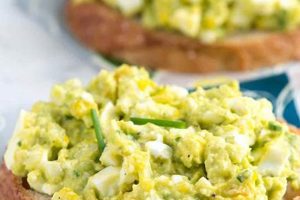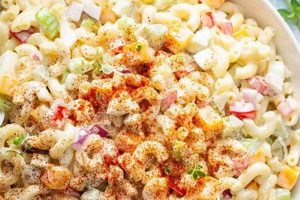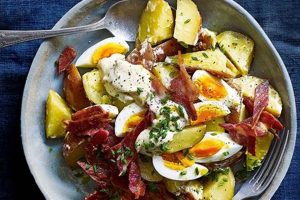A plant-based alternative to traditional egg salad, this dish typically utilizes tofu, chickpeas, or other legumes as a base. These ingredients are mashed or blended to achieve a texture similar to that of hard-boiled eggs. Various flavoring agents, such as vegan mayonnaise, mustard, nutritional yeast, black salt (kala namak for an eggy flavor), and chopped vegetables like celery and onion, are incorporated to mimic the taste and experience of classic egg salad. Numerous variations exist, featuring additions like avocado, curry powder, or different types of herbs and spices.
This culinary creation offers a cholesterol-free and often lower-fat option for those following a vegan lifestyle or seeking to reduce their consumption of animal products. It addresses the dietary needs of individuals with egg allergies while providing a familiar and comforting flavor profile. The increasing interest in plant-based diets has driven innovation in this area, resulting in a wide array of readily available recipes and commercially produced vegan egg salad alternatives. The dish contributes to a more sustainable food system by reducing reliance on animal agriculture.
The following sections will explore specific ingredient choices, step-by-step preparation methods, and creative serving suggestions for preparing a delicious and satisfying plant-based egg salad.
Tips for Crafting Exceptional Vegan Egg Salad
Achieving a truly satisfying vegan egg salad involves careful consideration of ingredients and techniques. The following tips provide guidance for creating a dish that rivals traditional egg salad in both flavor and texture.
Tip 1: Tofu Selection and Preparation: Opting for extra-firm tofu ensures a desirable texture. Pressing the tofu thoroughly removes excess water, preventing a watery final product. Crumbling or mashing the tofu to the desired consistency is key.
Tip 2: Kala Namak (Black Salt): This ingredient is essential for replicating the distinct sulfurous notes found in chicken eggs. A small amount goes a long way; start with a pinch and adjust to taste.
Tip 3: Vegan Mayonnaise Quality: Select a high-quality vegan mayonnaise that complements the other flavors. Experimenting with different brands can significantly impact the overall taste and creaminess.
Tip 4: Textural Enhancement: Finely diced celery, red onion, and other vegetables add a pleasant crunch and complexity. Consider incorporating chopped pickles or relish for a tangy twist.
Tip 5: Balancing Flavors: A touch of Dijon mustard or apple cider vinegar enhances the overall flavor profile. Nutritional yeast contributes a cheesy, savory element that complements the other ingredients.
Tip 6: Chilling for Optimal Flavor: Allowing the mixture to chill in the refrigerator for at least 30 minutes allows the flavors to meld and the texture to firm up.
Tip 7: Creative Serving Options: Explore serving the vegan egg salad on bread, crackers, lettuce wraps, or as a filling for sandwiches and wraps. It also makes an excellent topping for salads or baked potatoes.
By employing these strategies, one can create a vegan egg salad that is both flavorful and nutritionally sound. The result is a satisfying dish suitable for a variety of occasions.
The following section will conclude with some final thoughts and recommendations for enjoying this versatile plant-based creation.
1. Base Ingredient
The base ingredient forms the foundation of any vegan egg salad recipe, significantly influencing its texture, flavor, and nutritional profile. Selection of this core component requires careful consideration to achieve the desired outcome. Several options exist, each offering unique characteristics. Tofu, in its various forms, provides a neutral canvas, readily absorbing flavors while contributing a protein-rich element. Chickpeas offer a firmer texture and nuttier taste, boosting both protein and fiber content. Avocado, with its creamy consistency and healthy fats, creates a richer, more decadent egg salad alternative. Other less common options include cooked and mashed potatoes or sweet potatoes, hearts of palm, or even cooked and finely chopped cauliflower.
The choice of base ingredient directly impacts the recipe’s overall success. For a lighter, more traditional egg salad texture, crumbled or finely mashed tofu works well. When a heartier, more substantial salad is desired, chickpeas or white beans provide a robust foundation. Avocado lends a luxurious creaminess suitable for a more decadent preparation. Understanding these distinctions allows for informed decision-making and recipe customization. For example, a tofu-based egg salad might benefit from the addition of black salt to mimic the eggy flavor, while a chickpea-based version might require less mayonnaise due to its inherent moisture content. Similarly, avocados natural richness may allow for a reduction in added fats.
Careful consideration of the base ingredient’s characteristics is crucial for creating a successful vegan egg salad. This foundational element dictates not only the final texture and flavor but also the nutritional value. By understanding the properties of each option, one can tailor the recipe to specific dietary needs and preferences. This foundational knowledge empowers culinary creativity and ensures a satisfying and delicious final product.
2. Binding Agent
Binding agents play a crucial role in vegan egg salad recipes, providing the necessary cohesion and creaminess that mimics the texture of traditional egg salad. Without a suitable binder, the mixture would be loose and unappetizing. The binding agent emulsifies the other ingredients, creating a smooth, spreadable consistency. This characteristic is essential for achieving a satisfying sensory experience.
Vegan mayonnaise is the most commonly used binding agent in these recipes. Its emulsifying properties create a creamy texture that coats the other ingredients, holding them together. Other options include mashed avocado, which contributes healthy fats and a rich flavor, or blended cashews, which offer a slightly tangier profile and additional protein. The choice of binding agent influences not only the texture but also the flavor and nutritional composition of the final product. For instance, a recipe using avocado as a binder will have a richer, more distinct flavor compared to one using vegan mayonnaise. Similarly, using cashews will result in a higher protein content. Selecting the appropriate binder is crucial for achieving the desired outcome.
The careful selection and utilization of a binding agent are essential for a successful vegan egg salad. This component directly impacts the final texture, flavor, and nutritional value. Understanding the properties of various binding agents allows for informed decision-making and recipe customization. This, in turn, ensures a delicious and satisfying plant-based alternative to traditional egg salad.
3. Flavor Enhancers
Flavor enhancers are essential for transforming a simple mixture of plant-based ingredients into a convincing and satisfying vegan egg salad. These additions provide the characteristic savory, slightly sulfuric, and sometimes tangy notes associated with traditional egg salad. Without these key components, the final product may lack depth and complexity. The strategic use of flavor enhancers elevates the dish beyond a basic blend of ingredients, creating a culinary experience that resonates with the familiar flavors of classic egg salad.
Kala namak, or black salt, stands out as a crucial flavor enhancer in vegan egg salad recipes. Its sulfurous compounds mimic the distinct taste and aroma of chicken eggs, imparting an authenticity that other ingredients cannot replicate. Nutritional yeast contributes a cheesy, umami flavor that complements the other components, adding depth and complexity. Dijon mustard provides a subtle tanginess, balancing the richness of the vegan mayonnaise and other ingredients. Finely chopped onion, chives, or dill contribute freshness and aromatic complexity. A touch of smoked paprika can introduce a smoky dimension, while a pinch of turmeric adds a warm, earthy note. Lemon juice or apple cider vinegar provide brightness and acidity, balancing the overall flavor profile. The careful combination of these flavor enhancers produces a synergistic effect, resulting in a well-rounded and satisfying taste experience.
Successful vegan egg salad recipes rely heavily on the skillful application of flavor enhancers. These ingredients bridge the gap between plant-based components and the traditional flavors consumers expect. Kala namak, nutritional yeast, and various acidic and aromatic additions create a complex flavor profile that mimics the taste and aroma of classic egg salad. This careful orchestration of flavors ensures a satisfying and enjoyable culinary experience for those seeking a plant-based alternative to this traditional dish.
4. Texture Considerations
Texture plays a critical role in the overall enjoyment of vegan egg salad. Replicating the textural experience of traditional egg salad, which features a blend of creamy and slightly chunky elements, is key to achieving a satisfying plant-based version. The interplay of textures contributes significantly to the perceived authenticity and palatability of the dish. Without careful attention to texture, the result can be either too smooth and paste-like or too coarse and dry, detracting from the overall dining experience.
Several factors influence the final texture. The choice of base ingredient is paramount. For example, silken tofu creates a smoother, creamier base, while firm or extra-firm tofu, when crumbled, lends a chunkier consistency more akin to chopped eggs. Chickpeas, when mashed, offer a coarser texture. The addition of finely diced vegetables, such as celery, red onion, or bell peppers, introduces a contrasting crispness. The amount of binding agent used also affects the final texture; too much can result in an overly smooth, almost slimy consistency, while too little can lead to a dry, crumbly mixture. Achieving the desired balance of creamy and chunky elements often requires experimentation and adjustment based on personal preference and the specific ingredients used. For instance, a recipe using silken tofu might require less mayonnaise to avoid an overly smooth texture, whereas a recipe using chickpeas might benefit from a more generous amount of binder to create a cohesive mixture.
Careful consideration of texture is crucial for crafting a successful vegan egg salad recipe. Balancing the creaminess of the binding agent with the texture of the base ingredient and the added vegetables creates a dynamic and enjoyable sensory experience. Understanding the interplay of these elements allows for precise control over the final product, ensuring a satisfying plant-based alternative that mimics the textural complexity of traditional egg salad.
5. Serving Suggestions
Serving suggestions transform a vegan egg salad recipe from a simple mixture into a versatile component of various meals and snacks. Creative presentation elevates the dining experience, showcasing the dish’s adaptability and broadening its appeal beyond a basic preparation. Consideration of serving options expands the recipe’s utility, offering diverse applications for different occasions and culinary preferences.
- Classic Sandwiches and Wraps:
Traditional sandwich bread, croissants, or wraps provide familiar and convenient vessels for vegan egg salad. Adding lettuce, tomato, and sprouts enhances the nutritional value and textural complexity. This classic approach offers a quick and easy meal option, ideal for lunches or picnics. The familiarity of the format makes it an accessible entry point for those new to vegan cuisine.
- Salads and Bowls:
Vegan egg salad can serve as a protein-rich topping for green salads or grain bowls. Combining it with mixed greens, roasted vegetables, quinoa, or farro creates a nutritionally balanced and flavorful meal. This approach offers a lighter alternative to sandwiches while showcasing the egg salad’s versatility. The customizable nature of salads and bowls allows for creative combinations tailored to individual preferences.
- Appetizers and Snacks:
Serving vegan egg salad as a dip with crackers, crudits, or pita bread provides a flavorful and satisfying appetizer or snack. This format is well-suited for gatherings and parties, offering a convenient and shareable option. The versatility of this presentation allows for both casual and more formal settings.
- Stuffed Vegetables:
Utilizing vegan egg salad as a filling for tomatoes, avocados, or bell peppers creates a visually appealing and nutritionally dense meal. This approach offers a unique and elegant presentation, suitable for both casual and more formal dining occasions. The vibrant colors and varied textures enhance the overall sensory experience.
These serving suggestions demonstrate the adaptability of vegan egg salad, transforming it from a basic recipe into a versatile culinary component. The various applications cater to diverse dietary preferences and occasions, expanding the appeal of this plant-based dish. By considering these options, individuals can maximize the enjoyment and utility of their vegan egg salad creations.
6. Nutritional Value
Nutritional value represents a significant consideration within the context of vegan egg salad recipes. The inherent absence of cholesterol, a hallmark of plant-based diets, distinguishes these recipes from traditional egg salad. Moreover, the specific ingredients selected significantly impact the overall nutritional profile. For example, opting for a tofu base contributes a notable amount of protein and iron, while incorporating chickpeas increases both protein and fiber content. Utilizing avocado as a base introduces healthy monounsaturated fats and various vitamins. The nutritional composition of the chosen vegan mayonnaise also plays a role, with some brands offering lower fat or sodium content compared to others. The inclusion of vegetables like celery and red onion further enhances the vitamin and mineral content. Careful ingredient selection allows for customization to meet specific dietary needs and preferences. For instance, individuals seeking to increase protein intake might prioritize tofu or chickpea-based recipes, while those focusing on healthy fats might opt for avocado-based versions.
The nutritional benefits extend beyond basic macronutrients. Vegan egg salad recipes often offer a rich source of antioxidants, particularly when incorporating ingredients like red onion or dark leafy greens. The fiber content contributes to digestive health and satiety, promoting overall well-being. Choosing whole-grain bread or crackers for serving further enhances the nutritional value, adding complex carbohydrates and additional fiber. The absence of animal products eliminates the risk of consuming saturated fat and cholesterol, factors associated with cardiovascular disease. This makes vegan egg salad a heart-healthy alternative to traditional egg salad. Furthermore, the customization potential allows individuals to address specific dietary restrictions or preferences, such as gluten-free or low-sodium diets. For example, using gluten-free bread and low-sodium mayonnaise caters to these specific needs without compromising flavor or satisfaction.
Understanding the nutritional value inherent in vegan egg salad recipes empowers informed dietary choices. This awareness enables individuals to align their meals with specific health goals and preferences. By recognizing the nutritional contributions of each ingredient and selecting accordingly, individuals can maximize the health benefits associated with this versatile plant-based dish. The ability to customize the recipe to meet individual needs further underscores the importance of nutritional awareness in the context of vegan egg salad preparation. This understanding contributes to a holistic approach to healthy eating, allowing individuals to enjoy a flavorful and nutritious meal that supports their overall well-being.
Frequently Asked Questions
This section addresses common inquiries regarding vegan egg salad recipes, providing clarity and practical guidance for both novice and experienced cooks. These responses aim to dispel misconceptions and offer helpful tips for achieving optimal results.
Question 1: What can be used as an egg replacement in vegan egg salad?
Several ingredients effectively replicate the texture and/or flavor of eggs in vegan egg salad. Tofu, chickpeas, avocado, and even cooked potatoes offer suitable bases, each contributing unique characteristics. Choosing the appropriate substitute depends on desired texture and flavor preferences.
Question 2: How is the “eggy” flavor achieved in vegan egg salad?
Kala namak, also known as black salt, is the key to achieving the characteristic “eggy” flavor. This salt contains sulfur compounds that mimic the taste and aroma of chicken eggs. Nutritional yeast also contributes a savory, slightly cheesy flavor that complements the overall profile.
Question 3: How can one ensure a creamy texture in vegan egg salad?
A high-quality vegan mayonnaise serves as the primary binding agent and contributes significantly to the creamy texture. Mashed avocado or blended cashews can also enhance creaminess while adding nutritional value. The ratio of binding agent to base ingredient should be adjusted based on the specific ingredients used.
Question 4: How long does vegan egg salad keep in the refrigerator?
Properly stored in an airtight container, vegan egg salad typically lasts for 3-5 days in the refrigerator. Factors such as the freshness of ingredients and storage temperature can influence shelf life. It is essential to observe any signs of spoilage, such as off-odors or discoloration, before consumption.
Question 5: Can vegan egg salad be frozen?
While freezing is not generally recommended, as it can negatively impact the texture upon thawing, some base ingredients, such as chickpeas, freeze better than others. Freezing may result in a watery consistency upon thawing, particularly with tofu-based recipes. If freezing is necessary, consider using it as an ingredient in cooked dishes after thawing.
Question 6: How can the nutritional value of vegan egg salad be maximized?
Nutritional value can be enhanced by selecting nutrient-rich base ingredients like chickpeas or avocado. Incorporating a variety of chopped vegetables increases vitamin and mineral content. Using a low-fat, low-sodium vegan mayonnaise and serving the salad on whole-grain bread further contributes to a healthier profile.
Understanding these common queries empowers individuals to confidently create delicious and nutritious vegan egg salad. This knowledge base provides a foundation for successful experimentation and adaptation of recipes to individual preferences and dietary needs.
The subsequent section will offer concluding thoughts and recommendations for enjoying this versatile plant-based dish.
Vegan Egg Salad Recipe
Exploration of vegan egg salad recipes reveals a dynamic interplay of ingredients and techniques. Achieving a satisfying culinary experience hinges on careful selection of base ingredients, binding agents, and flavor enhancers. Textural considerations, serving suggestions, and nutritional value further contribute to the overall success of these plant-based creations. From classic sandwiches to innovative salads and appetizers, the versatility of vegan egg salad allows for diverse culinary applications. The ability to customize recipes based on individual dietary needs and preferences underscores the adaptability of this dish. Understanding the core principles of ingredient selection and preparation empowers culinary creativity and ensures a satisfying outcome.
The increasing demand for plant-based alternatives presents an opportunity for continued innovation within the realm of vegan egg salad recipes. Exploration of novel ingredients and techniques promises further refinement and expansion of culinary possibilities. As culinary awareness regarding plant-based cuisine evolves, vegan egg salad stands poised to become a staple in kitchens worldwide, offering a delicious, nutritious, and ethical alternative to traditional egg salad. This ongoing evolution underscores the potential of plant-based cuisine to satisfy both culinary desires and ethical considerations, contributing to a more sustainable and compassionate food landscape.






